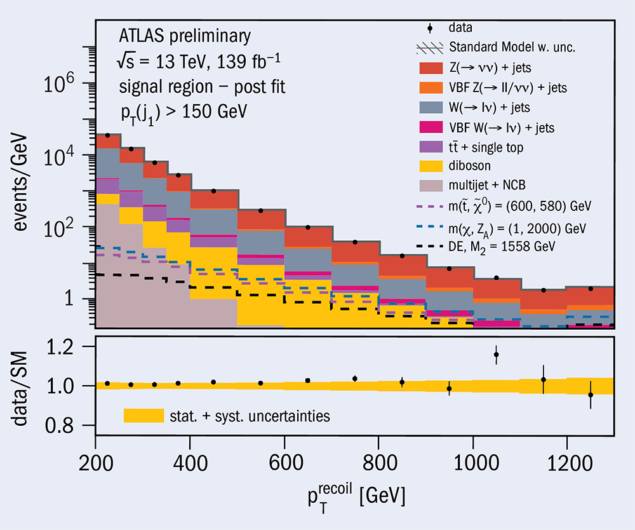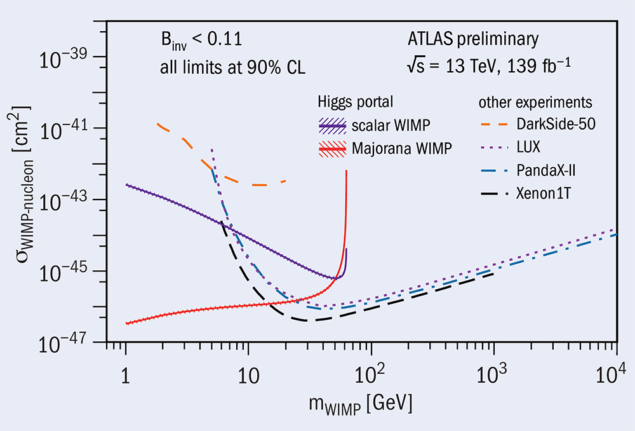A report from the ATLAS experiment
Dark matter is estimated to account for an unseen 85% of matter in the universe, but its nature is unknown. One possible explanation is weakly-interacting massive particles, or WIMPs, which could interact with ordinary matter through the exchange of a Higgs boson (“Higgs-portal” models) or a new mediator field yet to be discovered. The ATLAS collaboration has recently released two new investigations of WIMPs based on the full Run-2 data set.

At the LHC, a mediator may be produced and decay into a pair of stable WIMPs, which then escape the detector unseen – an undetectable process, unless the mediator is produced, for example, in association with a high-pT gluon radiated from one of the incoming protons. This would provide a clear signature: a high-pT jet and significant missing transverse momentum (MET). A first “monojet” analysis sought events with MET in excess of 200 GeV, recoiling against a jet with pT > 150 GeV, with up to three additional jets and no leptons or photons. The leading background arises from events wherein a Z boson decays to neutrinos – a process experimentally indistinguishable from WIMP production. The predictions of this and other backgrounds benefitted from stateof- the-art theoretical calculations, detailed groundwork on particle reconstruction in ATLAS, and the use of data-control regions rich in W and Z boson decays. No significant excess was observed with respect to the Standard Model (SM) (figure 1).
As invisible Higgs-boson decays have a branching fraction of just 10–3, any signal would indicate new physics
Dijet analysis
A second “dijet” WIMP analysis searches for invisible decays of Higgs bosons produced via vector-boson fusion. Though accounting for just 10% as many Higgs bosons as the dominant gluon-fusion process at the LHC, the topology’s clear signature, with two widely separated jets in pseudorapidity, lends itself to searching for MET, as the jets tend to be close together in the transverse plane when recoiling against a Higgs boson with pT > 200 GeV. The art of this analysis is again in the precise modelling of SM backgrounds – a feat accomplished here with extrapolations from control regions and the use of jet kinematics to separate signal events from Z-boson decays to neutrinos, and W decays with an undetected charged lepton. As invisible Higgs-boson decays in the SM (chiefly H → ZZ* → 4ν) have a branching fraction of just 10–3, any significant signal would indicate new physics. No deviation from the SM was observed, allowing a 95% confidence upper limit to be placed on the branching fraction for invisible Higgs-boson decays of 13% – a factor two improvement in sensitivity compared to the previous analysis, despite the increase in pileup – or 9% when combining with other ATLAS Higgs-boson measurements. The results are complementary to direct-detection experiments looking for relic WIMPs with deep underground detectors, as they plumb lower WIMP masses than direct-detection experiments can currently access (figure 2).

These results also translate into limits on alternative dark-matter-related theories such as axion-like-particles (ALPs) and large extra-dimensions, and into model-independent limits on new phenomena. ATLAS will continue to explore the parameter space of dark-sector models such at ALPs, dark photons, dark scalars and heavy neutral leptons, complementing the results of dedicated smaller-scale experiments.
Further reading
ATLAS Collaboration 2020 ATLAS-CONF-2020-048.
ATLAS Collaboration 2020 ATLAS-CONF-2020-008.
ATLAS Collaboration 2020 ATLAS-CONF-2020-027.






